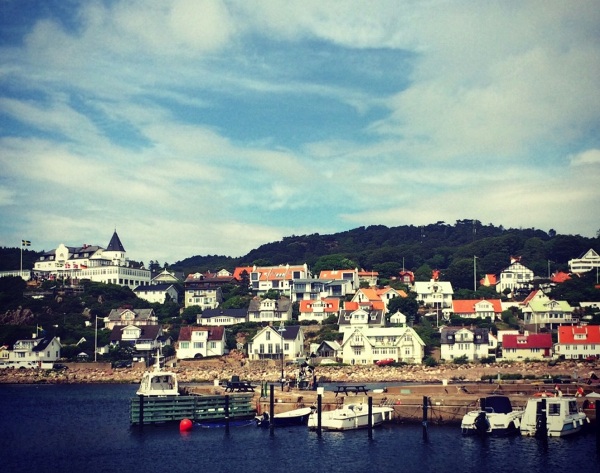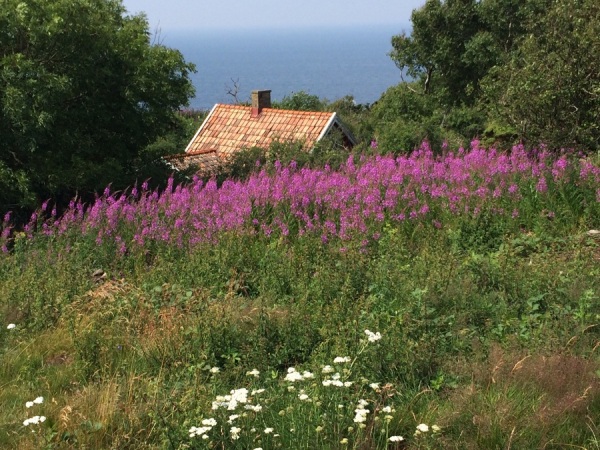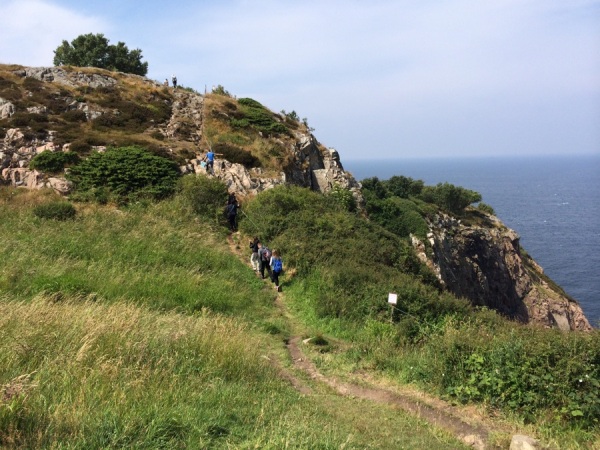By Maxine Sheppard
Queuing up to buy a plate of freshly fried herring, I noticed a small crowd of people alongside Mölle’s harbour wall, pointing smartphones at the water as it slopped back and forth. What was lurking? Lunch in hand, I wandered into the throng and saw a fluther of ghostly white jellyfish drift towards the slipway, their bell-like bodies slowly pulsating. We all stood for a while, mildly transfixed, and then dispersed. That was enough excitement for one day.
On the southern edge of Skåne’s Kullaberg peninsula, the pretty port of Mölle is variously described as sleepy, idyllic, affluent. In tourism terms, the small fishing town is best known today as the starting point for boat trips along the peninsula’s rugged coastline or as a base for outdoor enthusiasts looking to explore the Kullaberg nature reserve. But in the late 19th century the quiet resort enjoyed an altogether more scandalous reputation when it became one of the first places in Europe to allow mixed sex bathing on the nearby beach at Ransvik, attracting broad-minded tourists in their tens of thousands. As word spread, Mölle became increasingly fashionable, not just within Sweden but to hordes of pleasure-seekers from Britain, France, Denmark and Germany who arrived by steamboat from Copenhagen or the direct weekly train service from Berlin – and Sweden’s enduring reputation as a liberal utopia was born.
The outbreak of World War One put a dampener on Mölle’s free and easy lifestyle, and its status as a hotbed of hedonism was never to return. But the grand summer residences and hotels remain, occupying elevated positions on the peaceful streets above the harbour. Nowadays, Mölle’s relative lack of activity is part of its appeal. A century after its heyday, the town has morphed into a casually upmarket getaway for nature-loving weekenders, who – between a guided kayaking trip or a stint of rock climbing – are more than happy to gaze at jellyfish and feast on the morning’s catch.
Just north of Mölle, the anvil-like tip of the Kullaberg peninsula juts out into the Kattegat strait, a busy commercial shipping lane known for its difficult currents and frequent storms. The Kullen lighthouse – Scandinavia’s most powerful – squats at the extremity, keeping watch. Scarred over time with deep clefts and caves, the towering sea cliffs dominate the landscape for miles around, straddled by hiking paths which cut through juniper-covered heathland and pine forests.
Standing on the plateau looking back down the coast, I’m struck by how completely different this high terrain is to the rest of Skåne; a region of mostly low-lying evergreen forest and cultivated plains. Up here, clambering over ancient layers of stratified rock, it’s hard to get any sense of the county’s rich agricultural heritage – though a wealth of farm-fresh produce on local café menus tells me it can’t be too far away.
Instead, the weather-beaten peninsula is one of the west coast’s most isolated recreation areas, which helps explain the existence of its oddest attraction – a series of fortress-like driftwood towers on the northern shore known as Nimis, which went unnoticed by the authorities for a full two years. Built in 1980 by infamous Swedish artist Lars Vilks, the sculptures sparked a complex and protracted legal battle with the Swedish government and led to Vilks founding the one kilometre square micronation of Ladonia in 1996 to protect them. Today Ladonia claims more than 17,000 non-resident citizens, a royal family, and its own timezone – LST (Ladonia Standard Time) – pegged at three minutes behind Central European Time. Despite the total lack of signage, the local tourist office estimates some 40,000 tourists visit Nimis and Ladonia every year. Inaccessible by road, the only route is via a challenging 2.5km trail, though many are content to view the sculptures from one of the regular boat trips or porpoise safaris that pass this way.
But Kullaberg is not just for nation builders and thrill seekers. Yes, you can go mountain biking, abseil down a cliff or test your sea legs on a cave snorkelling excursion. But the abundance of wildflowers and birdlife, a nationally renowned golf course and secluded picnic areas lure those of a gentler persuasion too, making this windswept peninsula a literal and figurative high point in any Skåne itinerary.
Maxine Sheppard is a Sussex-based travel writer and editor with a penchant for long road trips, big mountains and wild animals. Follow her on Twitter @maxinesheppard.







